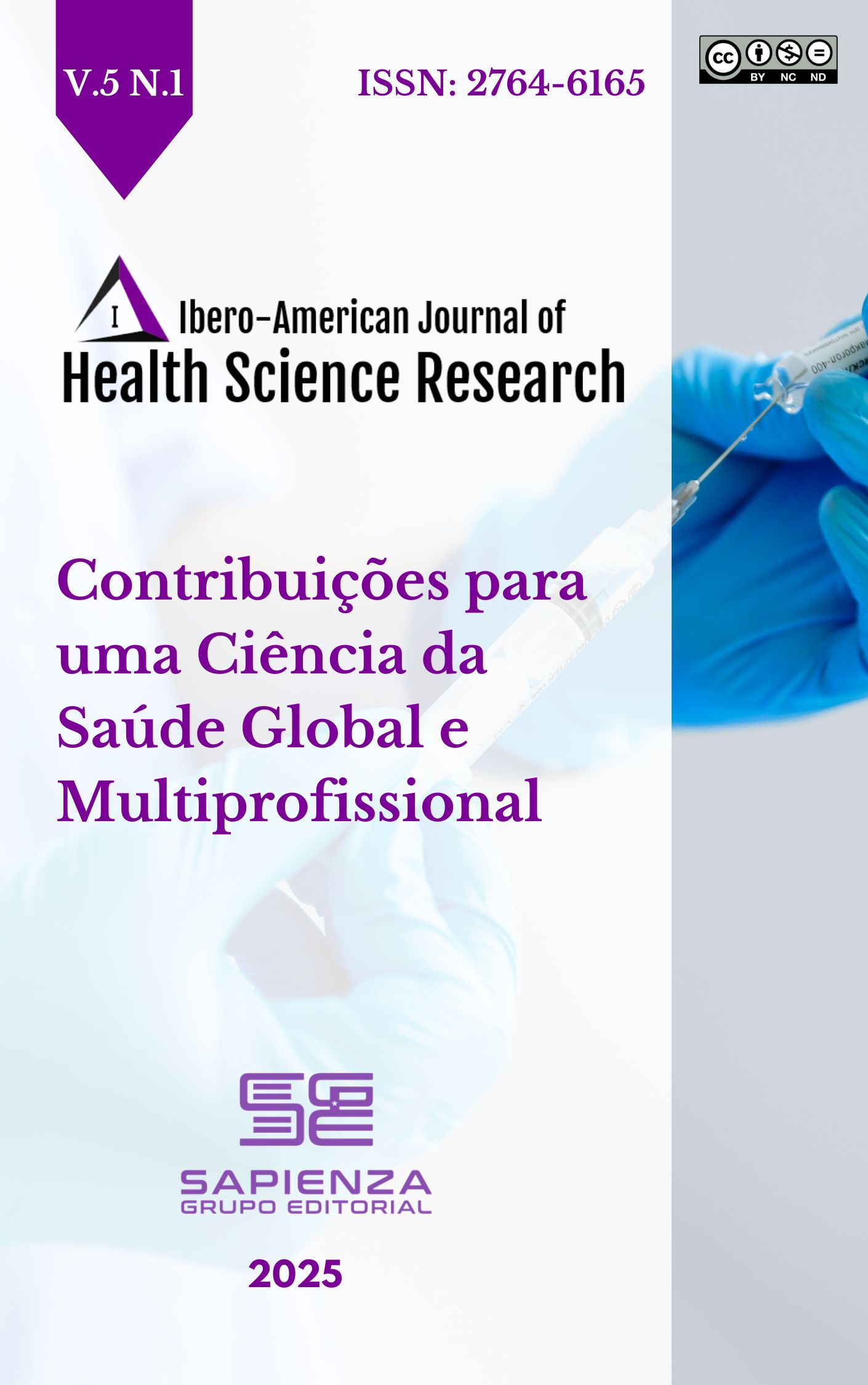Impact of artificial intelligence-guided cardiac ablation techniques on the management of complex arrhythmias: a systematic review
DOI:
https://doi.org/10.56183/iberojhr.v5i1.702Palavras-chave:
Artificial Intelligence, Cardiac Ablation, Complex Arrhythmias, Atrial Fibrillation, Precision Cardiovascular MedicineResumo
Global high prevalence of complex arrhythmias or atrial fibrillation (AF) ventricular tachycardia (VT) has burdened healthcare systems as these conditions contribute to stroke or lead to heart failure and sudden cardiac death. So these fetal conditions demand effective management strategies. Traditional approaches like antiarrhythmic medications and catheter ablation often have suboptimal outcomes with AF recurrence rates as high as 50% within one year. Advent of artificial intelligence (AI) in arrhythmia management has provided us innovative techniques for enhancing precision in ablation procedures. AI systems have now optimized arrhythmia mapping and has improved lesion accuracy at significant rate. Research confirmed that since ai has emerged, it uses is widely implemented because it has reduced procedural times by up to 25%. Most current papers show AI-guided ablation has achieved success rates over 85% lowering recurrence and complication rates when compared to those conventional methods. Challenges are limited validation in diverse populations and concerns regarding data privacy and algorithm biases. This paper is entirely based on most current papers which are published between 2019 and 2023. We evaluated the efficacy and safety of AI-guided cardiac ablation which is main aim of conducting this research. While technology demonstrates promising results yet it necessitates further validation and ethical considerations so that its use can be adopted more frequently at global level. Integration of AI into clinical practice offers potential advancements in precision cardiology but further research is required to address the existing gaps.
Referências
Baqal, O., Shafqat, A., Kulthamrongsri, N., Sanghavi, N., Iyengar, S. K., Vemulapalli, H. S., & El Masry, H. Z. (2024). Ablation Strategies for Persistent Atrial Fibrillation: Beyond the Pulmonary Veins. Journal of clinical medicine, 13(17), 5031. https://doi.org/10.3390/jcm13175031
Bundy, J. D., Heckbert, S. R., Chen, L. Y., Lloyd-Jones, D. M., & Greenland, P. (2020). Evaluation of risk prediction models of atrial fibrillation (from the Multi-Ethnic Study of Atherosclerosis [MESA]). The American Journal of Cardiology, 125, 55–62. https://doi.org/10.1016/j.amjcard.2019.08.035
Chen, E., Jiang, J., Su, R., Gao, M., Zhu, S., Zhou, J., & Huo, Y. (2020). A new smart wristband equipped with an artificial intelligence algorithm to detect atrial fibrillation. Heart Rhythm, 17(5), 847–853. https://doi.org/10.1016/j.hrthm.2020.01.017
Dörr, M., Nohturfft, V., Brasier, N., Bosshard, E., Djurdjevic, A., Gross, S., Raichle, C. J., Rhinisperger, M., Stöckli, R., & Eckstein, J. (2019). The WATCH AF trial: SmartWATCHes for detection of atrial fibrillation. JACC Clinical Electrophysiology, 5(2), 199–208. https://doi.org/10.1016/j.jacep.2024.11.013
Evbayekha, E., Antia, A., Dixon, B., Reiss, C. K., & Larue, S. (2024). Predictors Of Mortality And Burden Of Arrhythmias In Endstage Heart Failure. Current Problems in Cardiology, 102541.
Feeny, A. K., Chung, M. K., Madabhushi, A., Attia, Z. I., Cikes, M., Firouznia, M., ... & Wang, P. J. (2020). Artificial intelligence and machine learning in arrhythmias and cardiac electrophysiology. Circulation: Arrhythmia and Electrophysiology, 13(8), e007952.
Fox, S. R., Toomu, A., Gu, K., Kang, J., Sung, K., Han, F. T., Hoffmayer, K. S., Hsu, J. C., Raissi, F., Feld, G. K., McCulloch, A. D., Ho, G., & Krummen, D. E. (2024). Impact of artificial intelligence arrhythmia mapping on time to first ablation, procedure duration, and fluoroscopy use. Journal of Cardiovascular Electrophysiology, 35(5), 916-928. https://doi.org/10.1111/jce.16237
Grout, R. W., Hui, S. L., Imler, T. D., El-Azab, S., Baker, J., Sands, G. H., & et al. (2021). Development, validation, and proof-of-concept implementation of a two-year risk prediction model for undiagnosed atrial fibrillation using common electronic health data (UNAFIED). BMC Medical Informatics and Decision Making, 21, 112. https://doi.org/10.1186/s12911-021-01468-2
Guo, Y., Wang, H., Zhang, H., Liu, T., Liang, Z., Xia, Y., Yan, L., Xing, Y., Shi, H., Li, S., Liu, Y., Liu, F., Feng, M., Chen, Y., & Lip, G. Y. H.; MAFA II Investigators. (2019). Mobile photoplethysmographic technology to detect atrial fibrillation. Journal of the American College of Cardiology, 74(19), 2365–2375. https://doi.org/10.1016/j.jacc.2019.08.1017
Hill, N., Ayoubkhani, D., Lumley, M., Lister, S., Farooqui, U., McEwan, P., & et al. (2018). Incorporating time-varying clinical data into a machine learning algorithm to detect atrial fibrillation and flutter. Pharmacoepidemiology and Drug Safety, 27, 372–373. https://doi.org/10.1002/pds.4517
Hung, M., Lauren, E., Hon, E., Xu, J., Ruiz-Negrón, B., Rosales, M., & et al. (2020). Using machine learning to predict 30-day hospital readmissions in patients with atrial fibrillation undergoing catheter ablation. Journal of Personalized Medicine, 10, 82. https://doi.org/10.3390/jpm10030082
Lallah, P. N., Laite, C., Bangash, A. B., Chooah, O., & Jiang, C. (2023). The use of artificial intelligence for detecting and predicting atrial arrhythmias post catheter ablation. Rev. Cardiovasc. Med, 24(8), 215. https://doi.org/10.31083/j.rcm2408215
Lee, D. I., Park, M. J., Choi, J. W., & Park, S. (2022). Deep learning model for predicting rhythm outcomes after radiofrequency catheter ablation in patients with atrial fibrillation. Journal of Healthcare Engineering, 2022, 2863495. https://doi.org/10.1155/2022/2863495
Luongo, G., Vacanti, G., Nitzke, V., Nairn, D., Nagel, C., Kabiri, D., & et al. (2022). Hybrid machine learning to localize atrial flutter substrates using the surface 12-lead electrocardiogram. Europace, 24, 1186–1194. https://doi.org/10.1093/europace/euab142
Mascarenhas L, Downey M, Schwartz G, Adabag S. Antiarrhythmic effects of metformin. Heart Rhythm O2 [Internet]. 2024 Apr 11;5(5):310–20. Available from: https://www.sciencedirect.com/science/article/pii/S2666501824000989
Perez, M. V., Mahaffey, K. W., Hedlin, H., Rumsfeld, J. S., Garcia, A., Ferris, T., Balasubramanian, V., Russo, A. M., Rajmane, A., Cheung, L., Hung, G., Lee, J., Kowey, P., Talati, N., Nag, D., Gummidipundi, S. E., Beatty, A., Hills, M. T., Desai, S., Granger, C. B., Desai, M., & Turakhia, M.; Apple Heart Study Investigators. (2019). Large-scale assessment of a smartwatch to identify atrial fibrillation. New England Journal of Medicine, 381(19), 1909–1917. https://doi.org/10.1056/NEJMoa1901183
Saiz-Vivo, J., Corino, V. D. A., Hatala, R., de Melis, M., & Mainardi, L. T. (2021). Heart rate variability and clinical features as predictors of atrial fibrillation recurrence after catheter ablation: A pilot study. Frontiers in Physiology, 12, 672896. https://doi.org/10.3389/fphys.2021.672896
Selçuk A. A. (2019). A Guide for Systematic Reviews: PRISMA. Turkish archives of otorhinolaryngology, 57(1), 57–58. https://doi.org/10.5152/tao.2019.4058
Setshego, M. K. The Prevalence of Arrhythmias in Acute ST-Segment Elevation Myocardial Infarction.
Tang, S., Razeghi, O., Kapoor, R., Alhusseini, M. I., Fazal, M., Rogers, A. J., & et al. (2022). Machine learning-enabled multimodal fusion of intra-atrial and body surface signals in prediction of atrial fibrillation ablation outcomes. Circulation: Arrhythmia and Electrophysiology, 15, e010850. https://doi.org/10.1161/CIRCEP.121.010850
Tiwari, P., Colborn, K. L., Smith, D. E., Xing, F., Ghosh, D., & Rosenberg, M. A. (2020). Assessment of a machine learning model applied to harmonized electronic health record data for the prediction of incident atrial fibrillation. JAMA Network Open, 3(e1919396). https://doi.org/10.1001/jamanetworkopen.2019.19396
Truong, E. T., Lyu, Y., Ihdayhid, A. R., Lan, N. S. R., & Dwivedi, G. (2024). Beyond Clinical Factors: Harnessing Artificial Intelligence and Multimodal Cardiac Imaging to Predict Atrial Fibrillation Recurrence Post-Catheter Ablation. Journal of cardiovascular development and disease, 11(9), 291. https://doi.org/10.3390/jcdd11090291
Wang, H., & Wu, J. (2021). A virtual reality based surgical skills training simulator for catheter ablation with real-time and robust interaction. Virtual Reality & Intelligent Hardware, 3, 302–314. https://doi.org/10.1016/j.vrih.2021.02.001
Wasserlauf, J., You, C., Patel, R., Valys, A., Albert, D., & Passman, R. (2019). Smartwatch performance for the detection and quantification of atrial fibrillation. Circulation: Arrhythmia and Electrophysiology, 12(11), e006834. https://doi.org/10.1161/CIRCEP.119.006834
William, A. D., Kanbour, M., Callahan, T., Bhargava, M., Varma, N., Rickard, J., Saliba, W., Wolski, K., Hussein, A., Lindsay, B. D., Wazni, O. M., & Tarakji, K. G. (2018). Assessing the accuracy of an automated atrial fibrillation detection algorithm using smartphone technology: The iREAD study. Heart Rhythm, 15(10), 1561–1565. https://doi.org/10.1016/j.hrthm.2018.06.013
Zhou, X., Nakamura, K., Sahara, N., Takagi, T., Toyoda, Y., Enomoto, Y., & et al. (2022). Deep learning-based recurrence prediction of atrial fibrillation after catheter ablation. Circulation Journal, 86, 299–308. https://doi.org/10.1253/circj.CJ-21-0785
Downloads
Publicado
Como Citar
Edição
Seção
Licença
Copyright (c) 2025 Andrea Soledad Martínez Quinteros, Felipe Arturo Treviño Acosta, David Sebastian Ramirez Calvillo, Paola Carolina Astudillo González, Theo Ricardo Mármol Muñoz, Ana José Franco Vaca

Este trabalho está licenciado sob uma licença Creative Commons Attribution-NonCommercial-NoDerivatives 4.0 International License.



